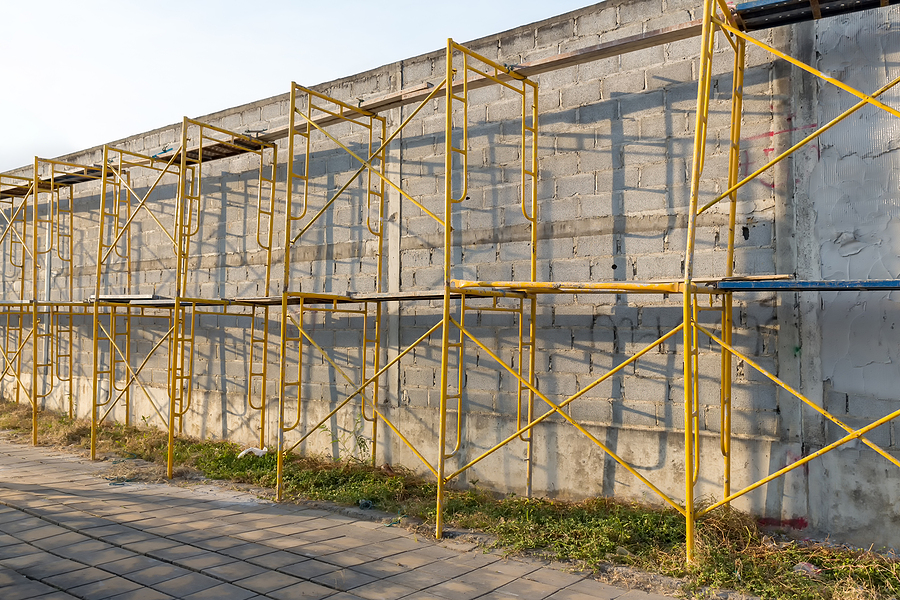Construction Scaffold Safety Inspection Schedule Spelled Out

When your construction site wants workers to do work at high elevations, you get scaffolds. It is the most convenient option available to consider. However, you need to make sure that your scaffolds are safe at all times. In fact, you should care about safety during design, installation, and even dismantling your scaffolds. Continue to read and we will share more details on how to inspect your scaffolds and ensure safety.
What exactly are scaffolds?
Scaffolds are something that you can often see in construction site. These are fixed, and large structures, which construction site workers use to access higher elevations. In most construction sites, scaffolds are the very first thing you see. These temporary structures can become large and complex, depending on the nature of construction activities you have to do. Due to the nature of scaffolds, specialists should install them at a construction site. After installation, you should also pay attention to regular inspections.
It is better if you can perform formal inspections on scaffolds at least once a week. However, there can be situations where you will need to inspect them sooner.
Why do you need to inspect your scaffolds?
Scaffolds provide ability for the construction site workers to work at elevated heights. However, working at heights can be risky. We often see how a lot of fatalities happen at construction sites where workers fall off from heights. This often happens due to improper installation of scaffolds.
We rarely hear about collapse of scaffolds. Even though a scaffold doesn’t collapse, it doesn’t mean that the structure is safe. An improperly installed scaffold can even lead construction site workers to serious injuries or fatalities.
When should you inspect your scaffolds?
Scaffolds are available in many different options. Single scaffolds, double scaffolds, suspended scaffolds, and trestle scaffolds are the most prominent options out of them. On top of these, you can also find mobile towers. No matter what the type of scaffolds is, all of them make construction site workers work at higher elevations.
You need to get a competent person to do regular inspection of scaffolds. This is a requirement implemented by the Work at Height Regulation. After the installation of scaffolds, you need to do a proper inspection. This is where you must verify that installation is safe to be used by your construction site workers.
Once installed, the scaffolds can be there for quite some time. This can lead to deterioration of scaffolds. That’s where regular scaffold inspection is important. Make sure that you do it at least once a week, so that you can meet health and safety conditions. If you notice any deterioration in the scaffolds, you need to get the help of an expert and fix it as soon as possible.
How to inspect scaffolding after assembly or installation
There are quite a few ways available for you to inspect scaffolds after their assembly or installation. Let’s take a look at how.
- You need to pick the correct access equipment to inspect your scaffolds. Then you can ensure safety while inspecting them at higher elevations.
- Make sure that you do a proper inspection of the scaffolds soon after installation. This should be done by a competent person.
- You should never use the scaffolds until a qualified person inspects them and provide you with the approval.
- You should inspect the scaffolds at least once a week.
- If you fail to do the inspection within 7 days, make sure that you don’t use it. Waiting for some time is worth than taking a risk.
What are the rules and regulations for inspecting scaffolds?
OSHA requires all construction sites to inspect their scaffolds regularly. This is clearly explained under the General Contractor topic in Section 1926.451(f)(3). According to it, you need to inspect both scaffolds and scaffold components for visible defects before each work shift. Even if something happens in the middle of the shift that impacts the structural integrity of scaffolds, you should do another inspection.
Other situations where you should inspect scaffolds
There are many other exceptional situations where you will need to do inspection of scaffolds. For example, you need to inspect them after severe weather conditions such as strong winds. Wind can blow down scaffolding, and you must ensure that it is safe to be used after that.
Even if you hit your scaffolding structure with something such as a vehicle or a machine, you need to do an inspection. Sometimes scaffolds are subjected to vandalism and unauthorized alternations. When you notice such situations, you must immediately attend to the scaffolds and do a proper inspection. During the inspection, you must pay attention to all parts of scaffolds. They include bracing, footing, guard rails, and all other components.
You should not just focus on the scaffolds. If there are any working platforms that allow construction site workers to work above 2 meters from the ground, you should inspect them.
Final words
Now you know how to properly inspect scaffolds. After the inspections, you can make sure that your scaffolds are safe to use. This is where you can allow the construction site workers to start working on their tasks. If you come across a situation where you feel that scaffolds are not safe, you mut instruct to stop work immediately. Then you need to do a proper inspection and start work only if the scaffolds are safe.
